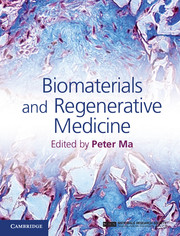Book contents
- Frontmatter
- Contents
- List of contributors
- Preface
- Part I Introduction to stem cells and regenerative medicine
- Part II Porous scaffolds for regenerative medicine
- Part III Hydrogel scaffolds for regenerative medicine
- Part IV Biological factor delivery
- Part V Animal models and clinical applications
- 25 Bone regeneration
- 26 Biomaterials for engineered tendon regeneration
- 27 Advancing articular cartilage repair through tissue engineering: from materials and cells to clinical translation
- 28 Engineering tissue-to-tissue interfaces
- 29 Models of composite bone and soft-tissue limb trauma
- 30 Tooth development and regeneration
- 31 Dentin–pulp tissue engineering and regeneration
- 32 Dental enamel regeneration
- 33 Hair follicle and skin regeneration
- 34 In-vitro blood vessel regeneration
- 35 Stem cells for vascular engineering
- 36 Cardiac tissue regeneration in bioreactors
- 37 Bladder regeneration
- Index
- References
35 - Stem cells for vascular engineering
from Part V - Animal models and clinical applications
Published online by Cambridge University Press: 05 February 2015
- Frontmatter
- Contents
- List of contributors
- Preface
- Part I Introduction to stem cells and regenerative medicine
- Part II Porous scaffolds for regenerative medicine
- Part III Hydrogel scaffolds for regenerative medicine
- Part IV Biological factor delivery
- Part V Animal models and clinical applications
- 25 Bone regeneration
- 26 Biomaterials for engineered tendon regeneration
- 27 Advancing articular cartilage repair through tissue engineering: from materials and cells to clinical translation
- 28 Engineering tissue-to-tissue interfaces
- 29 Models of composite bone and soft-tissue limb trauma
- 30 Tooth development and regeneration
- 31 Dentin–pulp tissue engineering and regeneration
- 32 Dental enamel regeneration
- 33 Hair follicle and skin regeneration
- 34 In-vitro blood vessel regeneration
- 35 Stem cells for vascular engineering
- 36 Cardiac tissue regeneration in bioreactors
- 37 Bladder regeneration
- Index
- References
Summary
Introduction
Normal blood vessels consist of three layers, including the tunica intima, the tunica media, and the tunica adventitia [1]. Each structural layer consists of distinct cell and matrix types. A monolayer of endothelial cells (ECs) lines the lumen of blood vessels to provide a continuous, selectively permeable, hemo-compatible blood-contacting surface. Meanwhile, ECs play a key role in various physiological and pathological processes including blood supply, metabolic homeostasis, immune cell trafficking, and inflammation [2]. Vascular smooth muscle cells (VSMCs) and pericytes cover the outside of the endothelium, protect the fragile channels from rupture, and contribute to the contraction and relaxation of the vessels [3]. The vascular wall extracellular matrix (ECM) is composed of structural proteins such as collagen and elastin and adhesion proteins such as fibronectin and laminin that determine mechanical strength, cell response, and ultimately hierarchical tissue organization [4]. An intact and functioning vasculature is crucial in order to maintain homeostasis and provides necessary nutrients and oxygen exchange to all parts of the body.
Diseases that affect the integrity of blood vessels lead to serious and often deadly outcomes. Vascular diseases are the major causes of morbidity around the world [5]. At present, approximately 12 million people in the USA are affected by peripheral vascular disease, but only approximately one in four of them has been diagnosed and is receiving treatment [6]. EC and SMC pathology has been implicated in various vascular diseases [7–10]. Current important therapeutic options for vascular disease incorporate the surgical implantation of stents or grafts and greatly reconstruct impaired vascular function to drain downstream tissues and organs. However, the implanted grafts may incompletely recover the functional integrity of the vasculature. In addition, these therapeutic methods neither provide long-lasting solutions nor prevent damage to downstream tissues and organs [11]. In this scenario, cell-based engineered vessel grafts may offer the opportunity to permanently and effectively treat many vascular diseases [11]. The regeneration of some or all of the vessel layers and their original properties may provide potentially functional vascular grafts. The use of autologous bypass grafts, including saphenous vein, internal mammary artery, and radial artery bypass grafts, remains an important therapeutic option for the treatment of coronary artery disease. However, many patients do not have a vessel suitable for use because of concomitant vascular disease, amputation, or previous harvest, and hence artificial grafts must also be used [12].
- Type
- Chapter
- Information
- Biomaterials and Regenerative Medicine , pp. 621 - 639Publisher: Cambridge University PressPrint publication year: 2014



